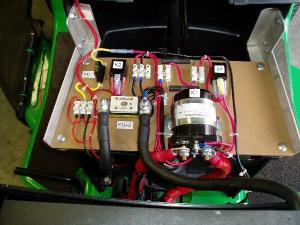2009 - Volume #33, Issue #4, Page #27
[ Sample Stories From This Issue | List of All Stories In This Issue | Print this story
| Read this issue]
Converted Electric Mower Runs Quiet And Cheap
 |
 |
"It looks like it takes about 3-amps or 75 cents worth of electricity to charge it back up after mowing. I used to spend $5 a week on gas," says Little. "After 21 changing cycles, I haven't blown a fuse or had any other problems."
Little has a half-acre lot, and a good part of it is on a fairly steep slope. He says mowing the lot takes him 25 to 30 minutes.
"From the front road to the back side of the lot, there is a good 6 ft. rise in elevation over 70 ft., " says Little. "The slope is steepest in the back, rising about 5 to 6 ft. in 25."
Little started his conversion with a 1997 Sabre that weighed 440 lbs. It had a 16 hp engine with hydrostatic drive and made a 38-in. cut. He removed the engine and replaced it with an Etek electric motor from Briggs and Stratton that delivers a constant 8 hp and up to 15 hp maximum.
For a power supply, he went with four 12-volt marine type, lead-acid batteries. To keep costs down, he bought "blemished" batteries, which he tries to baby, never allowing the charge to get under 37 volts. Eight weeks later, when completely reassembled, the "new" mower weighed 620 lbs. Little is confident that he could do another conversion in half the time.
"I was careful not to damage the structural integrity of the body since I was adding the weight," says Little. "The extra weight hasn't been a problem. It handles fine."
His 5-amp, three-stage charger delivers a full charge in 10 hours. However, since Little never completely drains the batteries, charging takes even less time. "I get about 23 to 25 minutes of mowing before I see a noticeable drop in rpm's," says Little. "At half an hour of mowing, I have pulled about 80 percent of my amp hours. I don't want to pull more, or I could damage my plates."
Installation of the new components was relatively easy. After removing the engine and gas tank, he mounted two batteries in the front and two in the rear. He had to make an adapter plate to match the existing drive pulley to the shaft of the electric motor. The Sabre is a unibody structural design with channels on each side of the mower.
"I was able to run my cables through the channels," explains Little. "I modified a digital voltmeter and ran the power through it. When the batteries get down to about 40 volts, I shut down to protect them. At this point, that is plenty of power to mow the lot."
Should Little want to mow for a longer period, all he has to do is buy more powerful, deep charge batteries. He says he could double his mowing time without changing anything else on the mower.
The total cost for the conversion came to $750. At a savings of $4.25 a week, it'll take him well over three years to cover his costs, even if he mowed once a week. However, the combination of quiet mowing and eliminating gas and oil fumes is worth it, he says.
Contact: FARM SHOW Followup, Gary Little, 1114 Oak Creek Dr., Conover, N.C. 28613 (ph 828 464-0268; kglittle@bellsouth.net; www.evalbum.com/2495).

Click here to download page story appeared in.

Click here to read entire issue
To read the rest of this story, download this issue below or click here to register with your account number.




